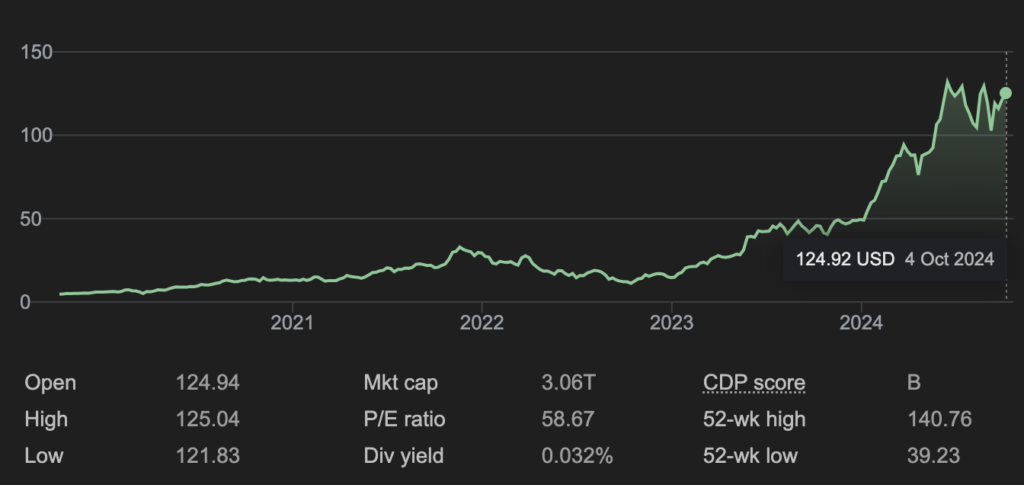Market Bubble: Nvidia’s Stock Surge (2021-2024)
Nvidia’s stock growth between 2021 and 2024, shows a significant rise in 2023–2024, driven primarily by the Artificial Intelligence (AI) boom. Nvidia is at the forefront of AI and machine learning development, as its GPUs are critical for deep learning models, making the company central to the AI narrative.

Key Points to Consider:
- Exponential Growth Linked to AI Hype: The graph clearly illustrates a sharp upward trajectory in Nvidia’s stock price, particularly from mid-2023. This corresponds with a surge in AI adoption across industries and the global excitement around AI-driven innovations, such as ChatGPT and generative AI models. The “AI gold rush” mentality, where investors pour money into companies that are perceived to be leaders in this space, has undoubtedly fueled Nvidia’s stock rise.
- Market Bubble Psychology: There are signs that Nvidia’s stock could be in a speculative bubble, driven by investor psychology. Market bubbles form when asset prices are driven far beyond their intrinsic value due to excessive demand, and Nvidia’s meteoric rise could be indicative of such a bubble. Bubbles are typically fueled by FOMO (fear of missing out), where investors continue to buy stocks despite high valuations, hoping that prices will keep rising. Historically, bubbles can form when investor sentiment overtakes rational decision-making, inflating stock prices to unsustainable levels.
- Valuation Concerns: Nvidia’s Price-to-Earnings (P/E) ratio, as shown, is currently at 58.67, which is quite high. This suggests that Nvidia’s stock price may not be fully supported by the company’s current earnings, meaning investors are paying a premium for future growth that may already be priced in.
- Comparison with Tech Bubbles: Nvidia’s situation resembles previous tech bubbles, such as the Dot-Com bubble of the late 1990s or the 2020s SPAC craze, where expectations about the future of technology caused stock prices to soar before crashing when reality didn’t meet expectations.
Research suggests that stock market bubbles tend to follow predictable patterns, much like the trajectories observed in high-flying tech stocks such as Nvidia and Cisco. The article from ICIS highlights that these bubbles often exhibit a rapid rise in stock prices driven by speculative enthusiasm, followed by a sharp decline once reality sets in. This phenomenon underscores the cyclical nature of market psychology, where investor sentiment can lead to irrational exuberance and subsequent corrections.
For a deeper understanding of this cyclical behavior and its implications for investors, the article provides valuable insights that reflect broader historical trends in market dynamics. You can read more about it in the ICIS research article.
What Investors Should Consider:
- Be Cautious with High Valuations: While Nvidia’s future in AI looks promising, the current price might reflect over-optimism about how quickly the company can continue to grow its profits. Investors who are heavily exposed to Nvidia stock should consider whether they are comfortable with the current valuation and the possibility of future volatility. We talk about this concept in our blog about predictable investment strategies.
- Profit-Taking or Risk Management: Given the current high valuation and historical precedents of bubbles correcting sharply, investors should consider either taking some profits off the table or implementing risk management strategies such as diversification. This can help reduce exposure if Nvidia’s stock experiences a correction or the AI hype subsides.
- Long-Term Potential: For long-term investors, Nvidia remains a fundamentally strong company with leading-edge technology, a dominant market position in GPUs, and vast potential in AI. However, they should be prepared for potential short-term volatility and be willing to ride out any corrections, keeping a long-term perspective in mind.
In conclusion, Nvidia’s recent surge is a clear reflection of market excitement around AI. However, investors should remain cautious, as high stock prices often signal higher risk. Balancing optimism with reality and monitoring the fundamentals of the business will help in navigating this environment successfully.
This MyArkade blog is intended to provide general information. Our commentary is based solely on historical data and analyst research, using an impartial methodology. The content is not meant to serve as financial advice and should not be considered a recommendation to buy or sell any stock. It does not take into account your personal objectives or financial situation. Our goal is to offer long-term, data-driven analysis grounded in fundamental information. Please note that our analysis may not reflect recent company announcements or qualitative factors. MyArkade holds no positions in any of the stocks discussed.











